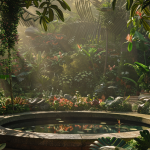The concept of sustainable design has become increasingly important in contemporary society. With rapid urbanization and the subsequent degradation of natural resources, sustainability has become a crucial aspect in the realm of urban development. One effective strategy that has gained considerable attention is the integration of rain gardens into urban landscapes. A sustainable rain garden design not only offers ecological benefits but also enhances the aesthetic appeal of urban spaces. This article aims to provide you with insights into some of the best strategies for designing rain gardens in urban developments.
Understanding the Concept of a Rain Garden
Before delving into the best strategies that guide the design of a sustainable rain garden, it’s essential to understand what a rain garden actually is. A rain garden is a shallow, vegetated depression designed to absorb and filter stormwater runoff from impervious surfaces such as roofs, driveways, walkways, parking lots, and compacted lawn areas.
A lire aussi : How Does the UK’s Changing Demographics Affect Senior Living Real Estate Investments?
Rain gardens are not merely aesthetic elements in a landscape, but purposeful eco-friendly features. They serve the dual purpose of improving water quality in nearby bodies of water and ensuring that rainwater becomes a resource rather than a waste product or a cause for concern. They can effectively reduce drainage problems and also improve the aesthetic appeal of a property.
Selecting the Appropriate Location
In designing a sustainable rain garden, the first strategy to consider is the selection of the appropriate location. The location you choose for your rain garden can either make or break its effectiveness.
A découvrir également : How to Implement Smart Irrigation Systems in UK Real Estate to Conserve Water?
Ideally, a rain garden should be situated at least 10 feet away from the building to prevent potential water damage. The garden should also be positioned in a natural depression or a flat area where rainwater can easily be directed. Furthermore, the location should have well-draining soil to allow the water to soak in rather than pool. So, the selection of location is a key step in establishing an effective and sustainable rain garden.
Choosing Suitable Native Plants
The choice of plants is another crucial strategy in sustainable rain garden design. The plants you select should not only be aesthetically pleasing but also serve the intended purpose of the garden.
Native plants are often the ideal choice for rain gardens. These plants are adapted to local conditions and can tolerate both extremes of moisture and potential drought. Moreover, they require less maintenance and are more resistant to pests and diseases, eliminating the need for harmful pesticides and fertilizers. The use of native plants also promotes local biodiversity, providing habitats for local wildlife.
Incorporating a Variety of Plants
To create a well-functioning, sustainable rain garden, incorporating a variety of plants is key. A diverse garden is more resilient to pests, diseases, and climate fluctuations and can provide a range of habitats for local wildlife.
A mix of trees, shrubs, perennials, and ground cover plants can create a layered structure that mimics natural ecosystems, improving both the functionality and aesthetic appeal of the garden. The variety of plants also ensures a longer blooming period, providing color and visual interest throughout the seasons.
Ensuring Proper Maintenance
While a well-designed rain garden can be low-maintenance, some care is needed to ensure its long-term sustainability. Ensuring proper maintenance is therefore an important strategy in the design of a sustainable rain garden.
Maintenance activities may include weeding, mulching, watering during dry periods, and potentially replacing plants that do not survive. Regular inspection of the garden, particularly after heavy storms, can help identify problems early, such as erosion or pooling water, and corrective measures can be taken promptly.
While the strategies discussed here provide a significant starting point, remember that every garden and every location will have unique requirements and challenges. A successful and sustainable rain garden design is not only about implementing these strategies but also about adapting them to the specific conditions of your site and your local environment.
The Role of Soil Preparation and Shaping
In designing a sustainable rain garden, one cannot overlook the importance of soil preparation and shaping. The composition and structure of the soil play a critical role in the garden’s ability to absorb and filter rainwater effectively. The type of soil in your chosen location can significantly impact your rain garden’s performance and its overall sustainability.
The ideal soil for a rain garden is loamy, which is a balanced mix of sand, silt, and clay. This type of soil has good water-holding capacity and excellent drainage, allowing it to absorb rainwater quickly and efficiently. If your site has clay or sandy soil, you might need to amend it with organic matter such as compost to improve its texture and water-holding ability.
Shaping the garden correctly is also crucial. The center of the rain garden should be the deepest point, encouraging water to flow towards it. Gentle slopes on the sides of the garden can guide rainwater into the garden, reducing runoff and erosion. The garden’s shape and depth should also be determined by the amount of water it is expected to handle. For instance, if your garden is designed to manage runoff from a large impervious area, it might need to be deeper to accommodate the additional water.
Incorporating Sustainable Drainage Systems
Another strategy for creating sustainable rain gardens in urban developments is the incorporation of sustainable drainage systems (SuDS). These systems are designed to replicate natural water processes, reducing the impact of urban development on the water cycle.
SuDS can be combined with rain gardens to enhance their effectiveness in managing stormwater. They provide a more holistic approach to water management, aiming to slow down and store rainwater, improve water quality, and enhance the surrounding environment.
Examples of SuDS that can be integrated with rain gardens include permeable paving, green roofs, and swales. Permeable paving allows rainwater to seep through into the ground rather than running off, reducing the amount of water that needs to be managed by the rain garden. Green roofs capture rainwater, reducing the volume that reaches the ground. Swales, on the other hand, are shallow channels designed to slow down and direct the flow of water, guiding it towards the rain garden.
Conclusion
Designing a sustainable rain garden in urban developments is a multi-faceted process that requires a careful understanding of the site, the selection of suitable plants, and the incorporation of effective water management strategies. It is about creating a space that not only enhances the aesthetic appeal of the urban landscape but also contributes positively to the local ecosystem and the broader environment.
By understanding the concept of a rain garden and implementing the strategies discussed in this article, you are well-positioned to create a sustainable, beautiful, and functional rain garden in your urban development. Remember that while these strategies provide a robust framework, they need to be adapted to fit the unique conditions of your site and local environment.
Ultimately, the success of a sustainable rain garden design lies in its capability to manage stormwater effectively, promote local biodiversity, and create an aesthetically pleasing urban space. It is a testament to the power of sustainable design in transforming urban landscapes, making our cities greener, more resilient, and more enjoyable places to live.











